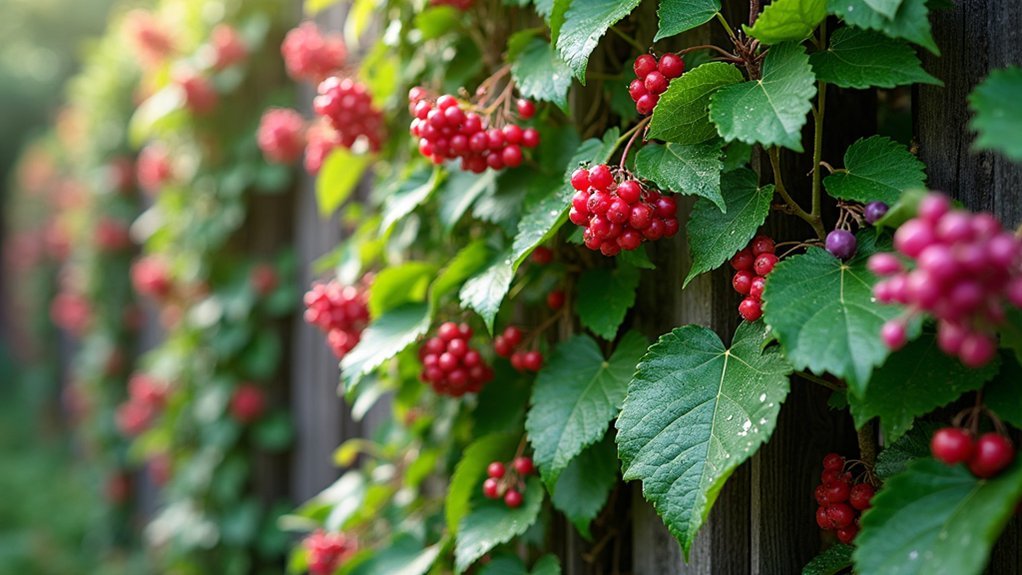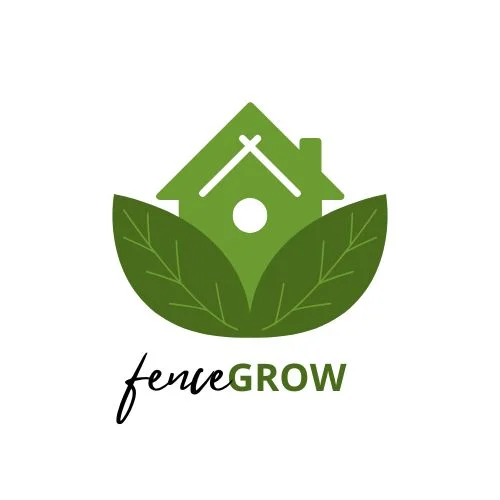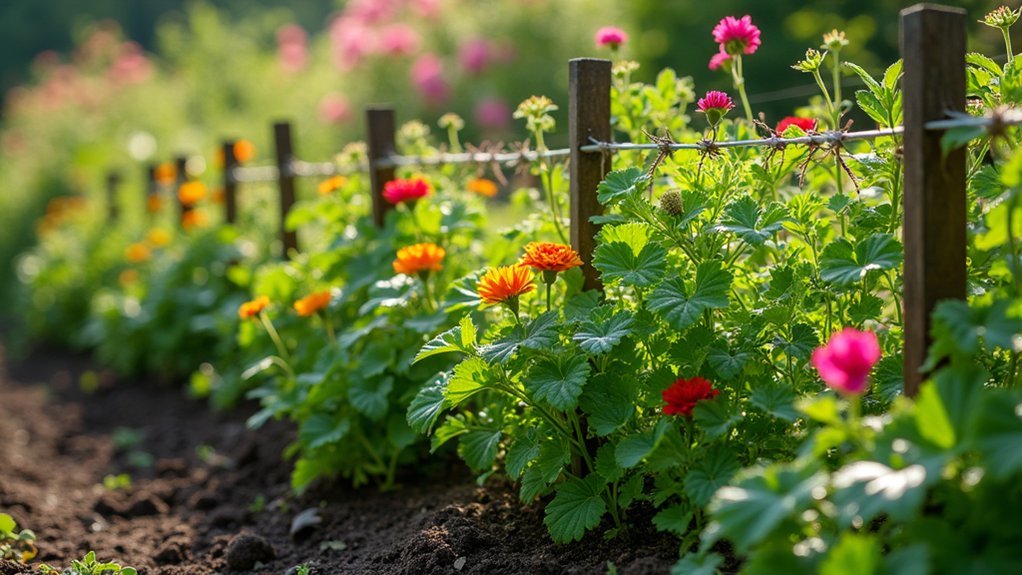For year-round edible fencing success, select hardy perennial climbers with varied harvest seasons and mix in semi-evergreens for winter coverage. Build sturdy support systems using rot-resistant woods and proper spacing. Create self-sustaining soil with regular compost additions and heavy mulching. Implement seasonal pruning to maintain productivity and air circulation. Layer compatible plants, combining tall climbers with lower edibles for continuous harvests. These five strategies will transform your ordinary boundary into a thriving food landscape.
Selecting Perennial Climbers for All-Season Privacy and Harvests

When creating edible fencing that serves you year-round, choosing the right perennial climbers becomes your most critical decision.
Look for plants with high hardiness ratings (H6 for colder regions) and varied edible parts to guarantee continuous harvests.
Potato beans offer tubers and climb to 2.5m+ in moist soil, while drought-resistant lablab beans provide edible leaves and pods.
Chayote delivers both fruit and foliage but needs sturdy support. For winter coverage, incorporate semi-evergreen varieties alongside deciduous producers.
Match plants to your specific climate zone and microclimate—south-facing fences extend growing seasons considerably.
Combine tall, vigorous climbers with lower-growing edibles to maximize both privacy and production. Kiwi plants can grow up to 20 feet tall and require both male and female plants for successful fruit production, making them excellent privacy screens.
Consider staggered planting times to guarantee continuous harvests from spring through fall.
Building Support Systems That Maximize Yield and Protection
The foundation of any successful edible fence lies in its structural support systems, which must balance durability with ideal growing conditions.
Choose naturally rot-resistant woods like black locust or Osage orange for posts, setting them 24-30 inches deep on flat stones rather than in concrete, which accelerates decay by wicking moisture.
- Space posts 8 feet apart for proper vine training, incorporating substantial corner bracing to withstand heavy fruit loads and wind stress.
- Design espalier forms and trellises using at least 12-gauge wire to maximize sunlight exposure while supporting dense fruiting vines like grapes or hardy kiwis.
- Create access pathways (about 3 feet wide) around your structures for comfortable maintenance and harvesting, ensuring your edible fence remains both productive and manageable.
Consider installing dead man anchors for additional stability when building trellises and espaliers that will bear significant weight over time.
Creating Self-Sustaining Soil Environments for Edible Borders

Successful edible fencing begins beneath the surface, where a thriving, self-sustaining soil ecosystem powers your productive boundary.
Regularly incorporate organic matter like compost to build fertility and support beneficial soil organisms that improve structure naturally.
Test your soil annually to understand its specific needs rather than guessing at amendments.
Implement cover crops during dormant periods to protect soil, fix nitrogen, and add organic material when tilled under.
Minimize chemical inputs that disrupt the soil’s natural balance.
Instead, mulch heavily around plants to retain moisture, suppress weeds, and gradually feed the soil as materials break down.
Consider establishing a compost system nearby to guarantee a steady supply of rich organic matter for your edible border’s ongoing health.
Aim for a soil pH between 6.0 and 7.0 for most edible plants, though some specialty crops may require adjustments.
Seasonal Pruning Strategies to Maintain Fence Productivity
Proper seasonal pruning transforms ordinary edible fences into productive, attractive boundaries that thrive year after year.
By adapting your approach to each season, you’ll guarantee structural stability while maximizing yields.
Season-specific pruning is the key to edible fences that stand strong while producing abundantly.
In spring, prune just before new growth emerges using clean, sharp tools to prevent disease transmission.
Summer requires attention to fruit load management and improved air circulation, while fall and winter dormancy periods offer ideal times for major structural work.
- Use espalier techniques for fruit trees to maximize space and yield while maintaining fence integrity
- Train vines on trellises to keep fruits off the ground and reduce disease pressure
- Remove deadwood promptly in any season to prevent pest infestations and maintain your fence’s aesthetic appeal
Incorporating blackberry and raspberry brambles creates edible fencing options that serve dual purposes of boundary definition and food production.
Layering Compatible Plants for Continuous Food Production

Creating a productive edible fence requires thoughtful layering of compatible plants that work harmoniously while providing food throughout the seasons.
Implement companion planting by pairing tomatoes with basil or incorporating herbs like mint with carrots for natural pest control and enhanced flavors.
For vertical space optimization, install trellises or netting on fences to support climbing beans and peas, while training fruit trees into espaliers against walls.
Combine drought-tolerant options such as sage and olive trees with seasonal producers to guarantee year-round harvests.
Develop polyculture systems by integrating citrus or pomegranate hedges with nitrogen-fixing plants beneath them.
Remember to prepare soil thoroughly, provide sufficient spacing between plants, and plan for seasonal interest through strategic combinations of edible hedge species like mulberries and coffee plants.
Aim to extend your harvest window by selecting a diverse range of fruit trees and berry varieties that ripen from June to November, creating a continuous food supply throughout the growing season.
Frequently Asked Questions
How Do I Manage Wildlife Attracted to My Edible Fence?
Use wildlife-friendly fencing with vinyl markers, install motion-activated deterrents, and create buffer zones with native plants. You’ll need to rotate methods seasonally and monitor with trail cameras to identify problem species.
Can Edible Fencing Work in Containers on Rental Properties?
Yes, you can create edible fencing in containers at rental properties. Use portable trellises, guarantee good drainage, and choose climbing plants like beans or compact fruit varieties. Always get your landlord’s approval first.
When Should I Replace Aging Perennial Climbers?
Replace aging perennial climbers when you notice reduced vigor, decreased fruit production, disease symptoms, or extensive physical damage. It’s typically time for renewal after 5-7 years or when harvest quality considerably diminishes.
How Do I Prevent Cross-Pollination Between Similar Edible Fence Species?
To prevent cross-pollination between similar fence species, you’ll need to use physical barriers like mesh bags, maintain proper distance isolation, stagger planting times, or install dense hedgerow buffers between potentially crossing varieties.
Are There Toxic Look-Alikes to Avoid When Planting Edible Fencing?
Yes, you should avoid toxic look-alikes like hemlock (resembles wild carrots), moonseed (mimics wild grapes), and spurge (similar to purslane). Always research thoroughly and verify plant identities before adding anything to your edible fence.
In Summary
You’ll find edible fencing transforms your property into both a private sanctuary and a productive food source. By selecting the right perennial climbers, building proper supports, nurturing self-sustaining soil, employing strategic pruning, and layering compatible plants, you’ve created a living boundary that produces food year-round. Now enjoy the fruits of your labor as you harvest from your beautiful, functional fence throughout the seasons.





Leave a Reply